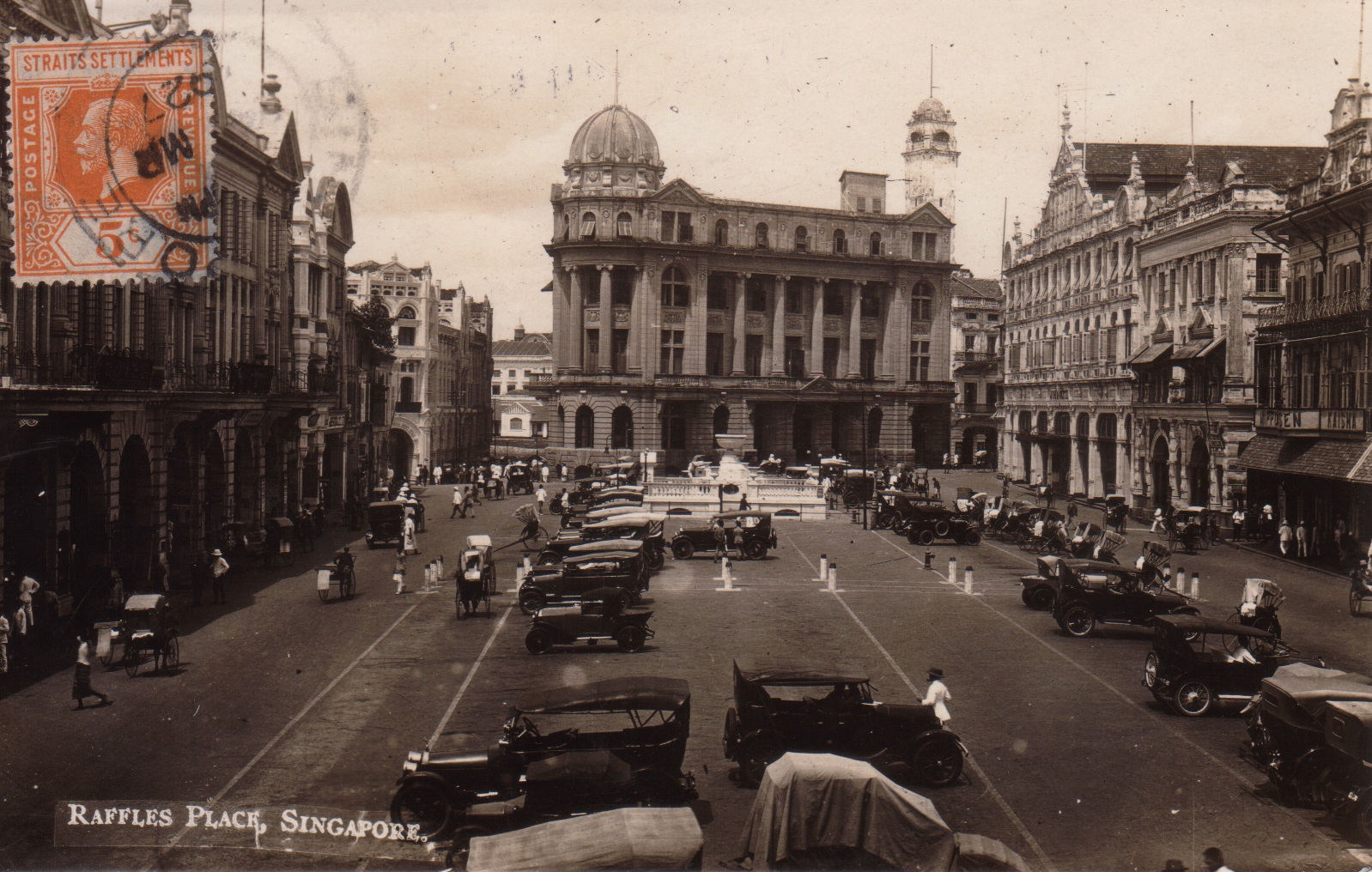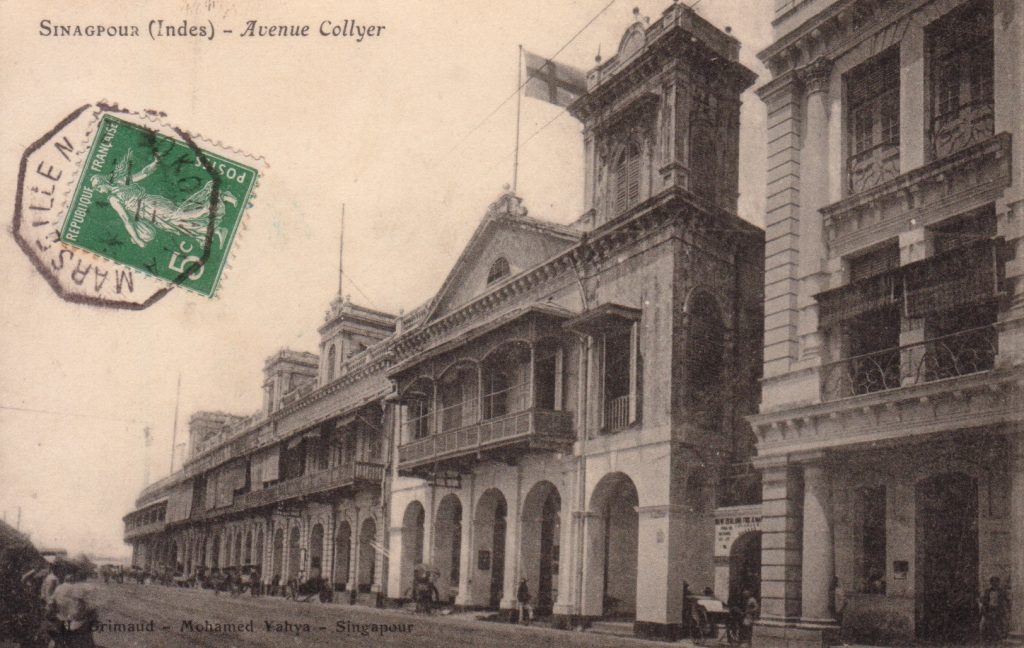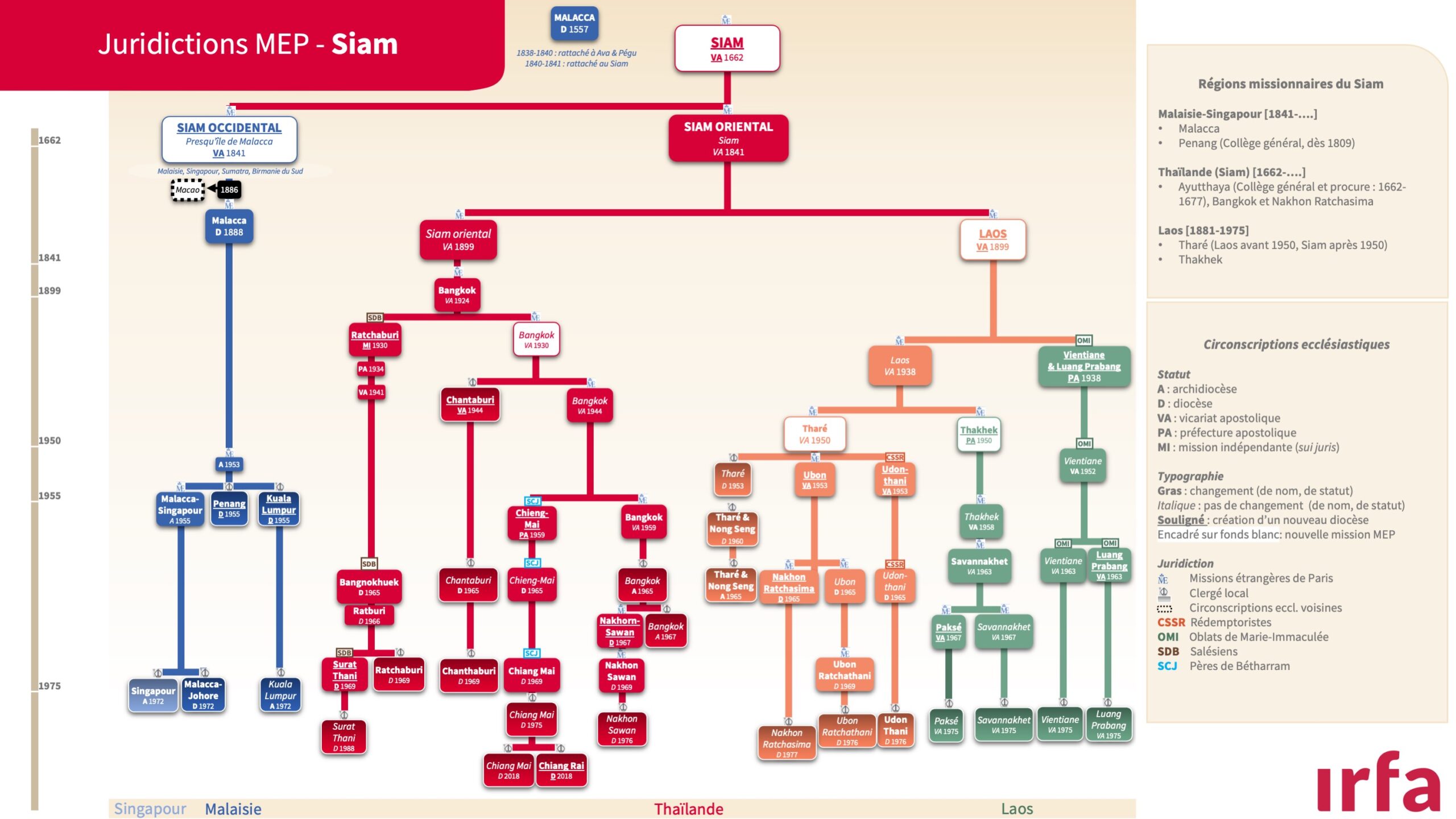
The MEP in Malaysia and Singapore (1662-1955) : an overview
Whilst the Malaysian peninsula is already part of the apostolic vicariate of Siam since 1673, it is only in 1821 that the MEP arrive in Singapore, with P. Laurent Imbert. In Penang, warm relations between the MEP fathers and the Kedah sultan and later with the British authorities allow for a durable implementation of Catholicism. The “Collège general” – a seminary for future priests from different Asian countries trained by the MEP – is founded in Penang in 1809.
In 1841, when the Malaysian mission is detached from the apostolic vicariate of Siam, the MEP are already established in Malacca, Penang, and Singapore. The rest of the peninsula is populated by Muslims Malays, who maintain very few contacts with the missionaries. In Singapore, from the 1830s onwards, the priests successfully work with Chinese immigrants, more opened to Catholic influences. Simultaneously, they turn to the aboriginals in the South Malaysian jungles. However, certain obstacles restrain the work of the missionaries, notably the conflicts with the Portuguese for reasons linked to the Padroado system, and a deficit in financial and human resources.
The missionary undertaking is facilitated by the 1874 Pangkor treaty, which asserts the British domination in the region. However, the treaty leaves their power of decision on religious matters to the sultans. This forces the MEP to continue to aim their activities only towards Chinese, Indian, aboriginals and non-Muslim communities.
From the MEP’s arrival until the beginning of the twentieth century, the clergy is mostly composed of foreign missionaries. However, from 1920 onwards, the increase in the number of local seminarians is followed by a growth in the number of indigenous priests. This trend is confirmed after the 2nd World War. During the post-war period, the MEP successfully complete their mission of creating a local and autonomous clergy, which continues to exist after the successive independences of Malaysia and Singapore.
Chronology
- 1662: Mgr Lambert de la Motte establishes the first seminary in Ayutthaya (Siam) for the formation of a local clergy.
- 1669: the apostolic vicariate of Siam is instituted; it includes the Malaysian peninsula.
- 1673: the apostolic vicariate of Siam is assigned to the MEP.
- 1779: the usurpation of the Siamese throne by Phaja Tak forces the missionaries to leave the country.
- 1781: Fathers Garnault et Coudé are the first MEP missionaries to reach the Malaysian peninsula.
- 1809: founding of the “Collège général” in Penang.
- 1821: P. Laurent Imbert arrives in Singapore. This marks the beginning of the MEP presence on the island. Rome includes Singapore in the jurisdiction of the apostolic vicariate of Siam by a decree from Leon XIII in 1827.
- 1827-1834: the catholic population of Penang grows from 1,200 to 4,000.
- 1841: the 10th of September papal brief Universi Dominici Gregis splits the Siam apostolic vicariate in two: Eastern Siam and Western Siam (or “Malacca peninsula Mission”), assigned to Mgr Courvezy (MEP).
- 1847: P. Borie is the first missionary mobilised to establish a mission in the jungles of South Malaysia, near the Orang Asli aboriginals.
- 1874: the Pangkor treaty is signed between the United Kingdom and the main sultans of the peninsula, marking the beginning of the British colonial administration of Malaysia.
- 1888: the diocese of Malacca is established.
- 1896: there are 32 MEP missionaries, 41 chapels and churches, 41 catechists, 57 catholic schools with 3,346 students, and 17,796 Catholics in the diocese of Malacca.
- 1911: ordination of P. Michael Seet, first indigenous priest.
- 1934: there are 67,545 Catholics in the diocese of Malacca.
- 1941-1945: Japan occupies Malaysia, seriously challenging the MEP missions in the region.
- 1947: 44 indigenous priests, 60 MEP priests, 6 Jesuits, 6 redemptorists, 160 brothers and 500 nuns from different congregations and institutions serve 105,000 Catholics in the diocese.
- 1955: the diocese of Malacca is split between the archdiocese of Malacca-Singapore, the diocese of Kuala Lumpur, and the diocese of Penang.
- 1957: Malaysia declares its independence.
- 1959: Singapore declares its independence.
CHARBONNIER Jean (MEP), « Les Missions étrangères en Malaisie et à Singapour », in Les Missions étrangères en Asie et dans l’océan Indien, Paris : Les Indes savantes, 2007, p. 135-149.
CHEW Maureen K. C., The Journey of the Catholic Church in Malaysia, 1511-1996, Kuala Lumpur : Catholic Research Centre, 2000.
DECROIX Paul (MEP), A short history of the Catholic Church in Taiping : 1897-1987 : Saint Louis Church Taiping, Penang : Percetakan Offset, 1987.
DECROIX Paul (MEP), History of the Church and Churches in Malaysia and Singapore (1511-2000), Penang, 2005
DECROIX Paul (MEP), Panorama of the history of the Catholic Church in Malaysia, Singapore and other countries, 1997.
GUILLOT Claude, « A propos de François Albrand (1804-1867) et de son dictionnaire malais : les Missions étrangères de Paris et la langue malaise au début du XIXe siècle », in Archipel, Paris, 1997, vol. 54, p. 153-172.
NEWTON BOSS James, An account of the Portuguese mission in Singapore (1825-1999) : founding of St. Joseph’s Church, Singapour : James Newton Boss, 2009.
PATARY Bernard, L’institution missionnaire en Asie (XIXe-XXe siècles). Le Collège général de Penang : un creuset catholique à l’époque coloniale, Paris : Karthala, 2016.
PILON Maxime & WEILER Danièle, The French in Singapore : an illustrated History (1819 – today), Singapour : Editions Didier Millet, 2011, 240 p.
TAN Rachel (dir.), From Outpost to Church. Singapore’s Catholic Journey, 1821-2021, Singapore : The Titular Roman Catholic Archbishop, 2021, 281 p.
WIJEYSINGHA Eugène & NICOLAS René (MEP), Going Forth… The Catholic Church in Singapore, 1819-2004, Singapore : Nicholas Chia, Archbishop of Singapore, 2006, 362 p.
Film
SIMONNET Christian (MEP), Malaisie, terre et ciel, 1971
De l’importation du christianisme par les Portugais à l’attribution du vicariat apostolique du Siam occidental aux MEP
- (1511-1841) Un développement du christianisme conditionné par la présence successive des puissances coloniales portugaise, hollandaise et britannique
- 1662 : premières tentatives d’évangélisation par les MEP
- 1809 : la création du Collège général de Penang
- 1821 : installation à Singapour et querelles de juridictions avec les Portugais
(1841-1874) Les débuts de l’administration britannique de la Malaisie
- 1841 : division du vicariat apostolique du Siam
- (1841-1888) A Singapour
- (1847-1871) Auprès des aborigènes de la jungle malaise
(1874-1955) Vers la création de la province ecclésiastique en Malaisie
- 1874 : l’accord de Pangkor et le début de l’administration coloniale britannique
- 1888 : création du diocèse de Malacca
- Les principaux obstacles à l’entreprise missionnaire
- 1875 : la Mission catholique du Perak
- La mission catholique du Sud
- L’accroissement du nombre de vocations, fruit du travail missionnaire
- (1941-1945) L’impact de l’occupation japonaise
De 1955 à la fin du XXème siècle : vers un clergé indigène
- (1945-1955) Réorganisation de la chrétienté
- 1955 : division du diocèse de Malacca et nomination des premiers évêques indigènes



 Download
Download

